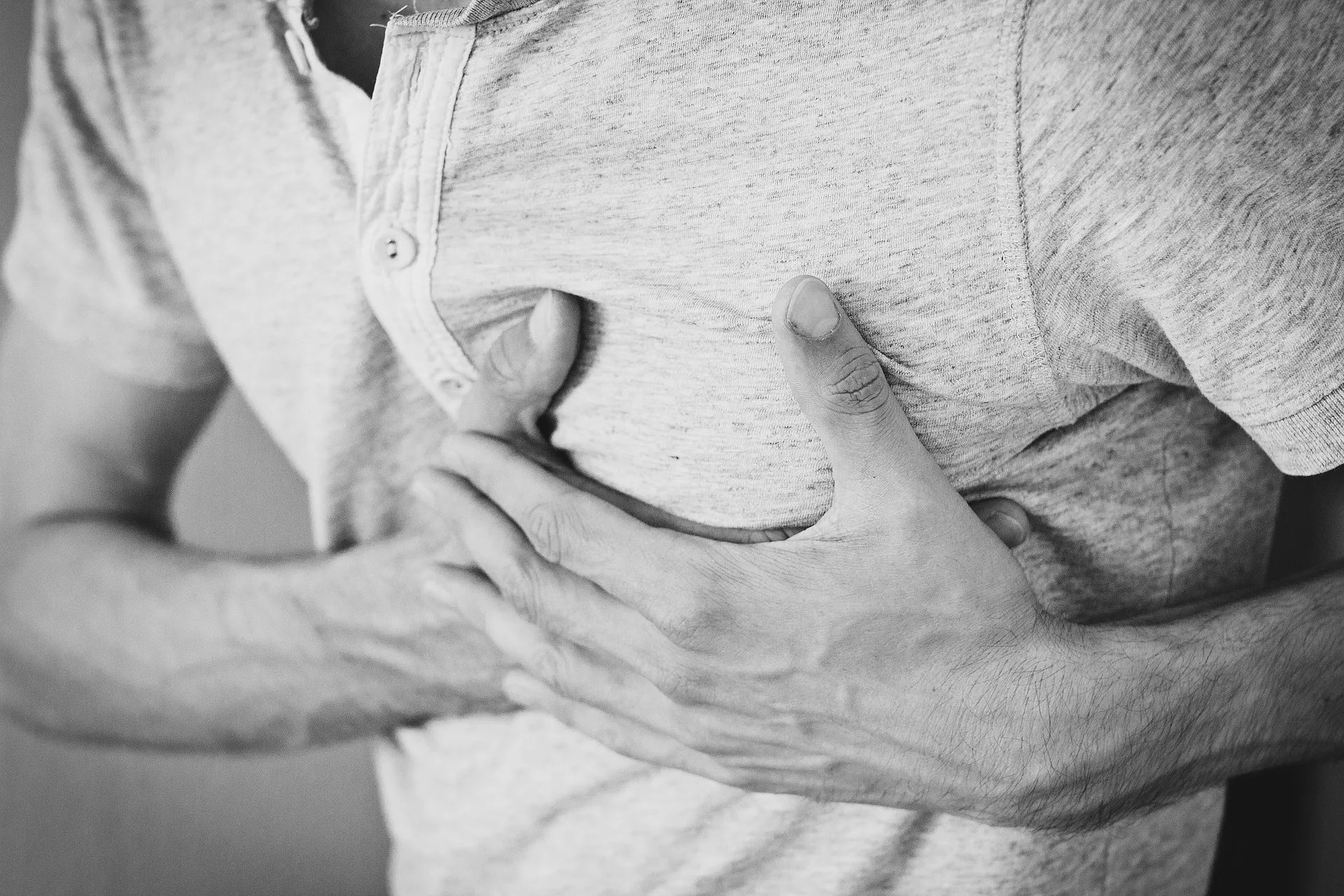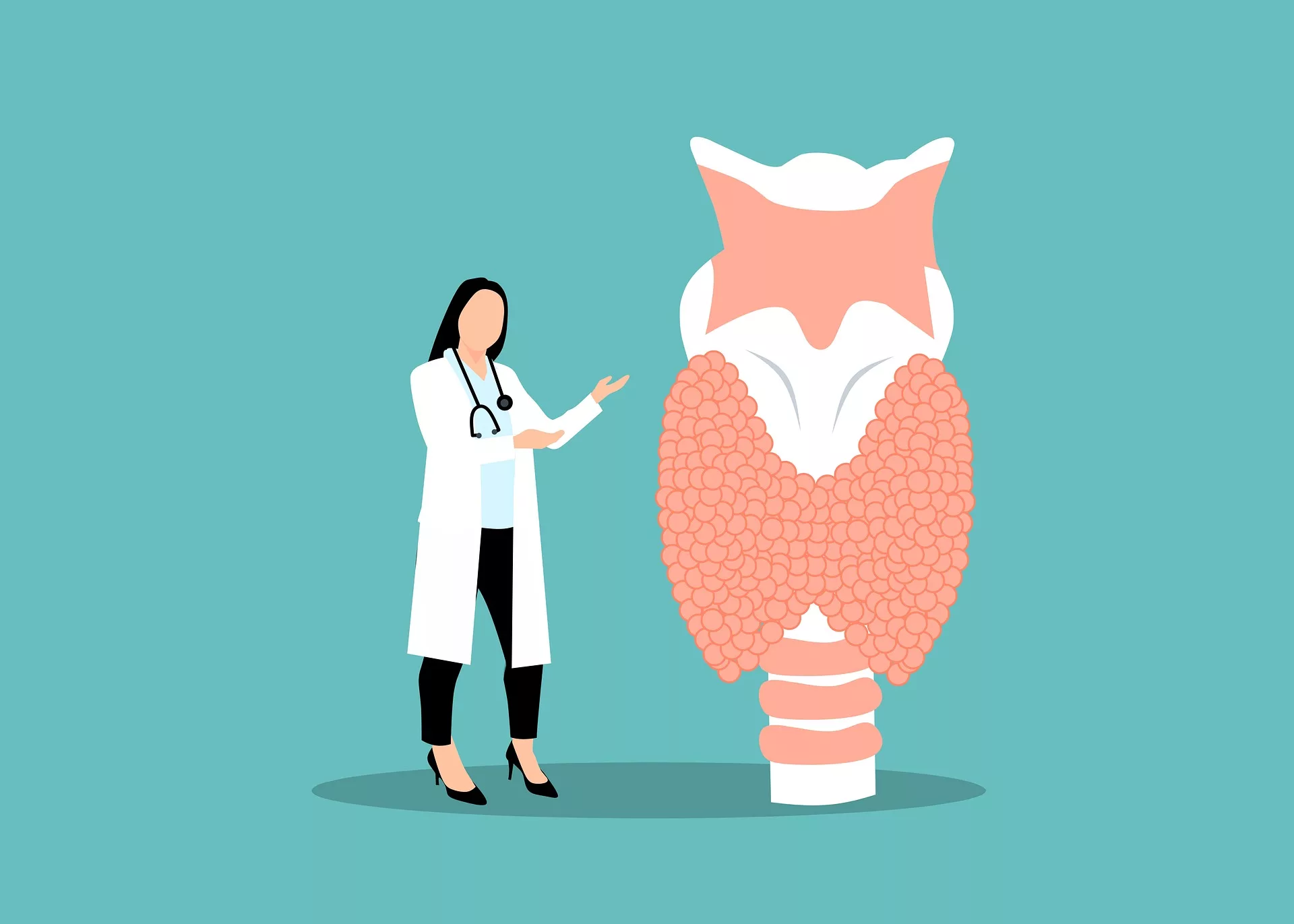Also known as a thyroid storm, thyrotoxic crisis is an emergency condition caused by excessively high levels of thyroid hormone in the blood. This rare disorder mostly affects patients diagnosed with hyperthyroidism. The most common symptoms include tachycardia (increased heartbeat rate above 140 per minute), high-grade fever, and confusion. If left unattended, it can quickly progress to heart failure and even death. Aggressive symptomatic management is the go-to treatment strategy.
The Role Of Thyroid Gland
The thyroid gland is one of the most important glands in the body, and it regulates your metabolism (the process of food breakdown and provision of energy). It is responsible for the release of two essential hormones called thyroid hormones, i.e., tri-iodothyronine (T3) and thyroxine (T4). These hormones control:
- Metabolism
- Heart rate
- Body temperature
Hyperthyroidism & Thyroid Storm
As the name indicates, hyperthyroidism refers to overactivation of the thyroid gland. It is characterized by increased production and secretion of the thyroid hormone. This type of gland overactivation arises due to some underlying issues, such as thyroiditis (inflammation of the thyroid gland), Grave’s disease (an auto-immune disorder that attacks the thyroid), thyroid adenoma (cancer), etc.
The thyrotoxic crisis is a rare complication of hyperthyroidism (especially Grave’s disease). According to reports, the incidence of thyrotoxic crisis in US adult populations was 0.5 to 0.76%/100,000 per year, accounting for 1-2% of all hospital admissions. The average age of patients is 42-43, and women are more likely to suffer from the disorder.1Galindo, R. J., Hurtado, C. R., Pasquel, F. J., García Tome, R., Peng, L., & Umpierrez, G. E. (2019). National trends in incidence, mortality, and clinical outcomes of patients hospitalized for thyrotoxicosis with and without thyroid storm in the United States, 2004–2013. Thyroid, 29(1), 36-43.
Causes Of Thyrotoxic Crisis
Researchers aren’t sure about the exact causes of the thyrotoxic crisis, but in most cases, it is triggered by some adverse events/situations in hyperthyroid patients. The majority of thyroid storm patients have an untreated or undertreated hyperthyroidism (going for a long time). Following is a list of triggers for thyroid crisis:

- Emotional distress
- Trauma
- Childbirth
- Infection (Epstein-Barr Virus)
- Heavy intake of iodine
- Acute diseases such as stroke, diabetic ketoacidosis, congestive heart failure and pulmonary embolism
- Surgery (thyroidectomy and non-thyroid surgery)
Modern clinicians identify emotional stress as a significant contributor to the thyroid storm.2Al Ghaiti, S., Al-rudaini, M., Alyamani, A., & Alreesi, A. (2024). Emotional Stress-Induced Thyroid Storm. Journal of Diabetes and Endocrine Practice, 7(01), 39-41. Leading gynecologists propose that a hyperthyroid patient’s condition can aggravate during pregnancy and after childbirth. Therefore, patients must be kept under strict observation, and treatment should be started without any delay.3Chen, Y. H., Liao, C. P., Lu, C. W., Lin, T. Y., & Chang, Y. Y. (2022). Thyroid Storm Superimposed on Gestational Hypertension: A Case Report and Review of Literature. Medicina, 58(3), 450.
Moreover, thyroidectomies and even non-thyroid surgeries can trigger thyroid storms in patients with poorly controlled hyperthyroid disease. Therefore, surgeons must pay special attention to the preoperative workup of such patients.4Shoja, M. M., Lopez, O. N., & Okereke, I. (2018). Acute thyroid storm following thymectomy: a surprising result of undiagnosed Graves’ disease. Cureus, 10(8). Excessive iodine intake (mostly in the form of dietary supplements) can lead to thyroid dysfunction and trigger thyrotoxic crises in patients.5Sohn, S. Y., Inoue, K., Rhee, C. M., & Leung, A. M. (2024). Risks of Iodine Excess. Endocrine Reviews, bnae019.
Thus, all hyperthyroid patients (especially Grave’s disease patients) must look out for these specific triggers to keep themselves safe from the life-threatening thyroid storm.
Thyrotoxic Crisis Symptoms
Emergency doctors and hyperthyroid patients must be aware of the evident symptoms of thyroid crisis to save precious time.
Fever & Sweating
Most patients present to the emergency department with a high-grade fever (between 104℉ and 106℉). Profuse sweating, raised body temperature, and fast heartbeat are common symptoms. Pyrexia always accompanies other serious complications, like abnormal breathing rates and a confused state of mind.
Increased Heartbeat (Tachycardia) & Systolic Hypertension
The vast majority of patients suffering from a thyroid storm report multiple adverse cardiovascular events. The most common symptom is tachycardia, i.e., a heartbeat that is above 100 beats/minute. This condition can quickly progress to cardiac arrhythmias and heart failure.6Waqar, Z., Avula, S., Shah, J., & Ali, S. S. (2021). Cardiovascular events in patients with thyroid storm. Journal of the Endocrine Society, 5(6), bvab040. Moreover, a rise of beats above 140 beats per minute can trigger serious heart problems like atrial fibrillation.7Martinez-Diaz, G. J., Formaker, C., & Hsia, R. (2012). Atrial fibrillation from a thyroid storm. The Journal of Emergency Medicine, 42(1), e7-e9.

Unfortunately, arrhythmias and fibrillation are common in patients. Moreover, congestive heart failure can prove to be fatal if not treated immediately. A storm of thyroid hormones raises systolic blood pressure. According to a clinical study, secondary hypertension can develop as a result of a thyrotoxic crisis.8Oetama, S., Andryan, D. P., & Lilyasari, O. (2024). 43. A Brewing Thyroid Storm: Secondary Hypertension due to Thyrotoxicosis Diagnostic Approach in Limited Setting. Journal of Hypertension, 42(Suppl 2), e11-e12. Respiratory distress may also be present due to multiple issues.
Altered State Of Mind
A lot of patients are brought to the hospital in an unconscious state. When conscious, patients suffering from excess thyroid hormones have an altered state of mind. There are multiple presentations of the neurological consequences of this hormone disorder. Sufferers are agitated and anxious. A state of confusion and disorientation (delirium) is also seen in numerous individuals. According to a clinical case report, unexplained delirium can be attributed to an underlying, undiagnosed thyrotoxic crisis. Therefore, hyperthyroidism should be checked in cases of unexplained arrhythmias and delirium.9Namita, S. UNEXPLAINED DELIRIUM: THINK OF THYROID STORM.
Other central nervous system (CNS) symptoms, such as seizures and comas, may also be present. Studies conclude that the presence of neuropsychiatric manifestations is linked to a greater risk of mortality.10Chng, C. L., & Lim, A. (2015). Clinical characteristics and outcome of thyroid storm: a case series and review of neuropsychiatric derangements in thyrotoxicosis. Endocrine Practice, 21(2), 182-189. In the ER, a lot of patients are shaky due to high body temperature and psychological issues.
Gastrointestinal Upset
GI symptoms are uncommon. However, when present, the most prevalent complications are nausea, vomiting, and diarrhea. Additionally, abdominal pain and jaundice may also be present. Studies show various types of gastrointestinal-hepatic symptoms can be seen, ranging from nausea to vomiting and jaundice (yellowing of the skin).11Idrose, A. M. (2015). Acute and emergency care for thyrotoxicosis and thyroid storm. Acute medicine & surgery, 2(3), 147-157.
How To Diagnose Thyrotoxic Crisis?
The mortality rate of thyrotoxic crisis is over 10%. This life-threatening condition worsens very quickly. Therefore, a quick diagnosis and immediate medical attention is the ultimate requirement. Diagnosis mainly relies on clinical features and not on test findings. The rule of thumb in a suspected thyroid crisis patient is to start treatment without waiting for laboratory confirmation.
Diagnostic Tests:
Thyroid Function Tests
In thyroid studies, you will find elevated levels of:
- Tri-iodothyronine (T3)
- Thyroxine (T4)
- Free T4
There is an increased T3 resin uptake and decreased thyroid-stimulating hormone (TSH levels). The overproduction of the thyroxine hormone causes the 24-hour iodine uptake to also rise. These results point towards hyperthyroidism. However, these test findings are only useful if hyperthyroidism has not been previously diagnosed in the patient.
Radiographic Imaging
Radiographic tests related to thyroid storm diagnosis include chest radiographs, and Head CT scans. Chest X-rays aid in checking cardiac enlargement due to congestive heart failure and help diagnose the consequences of heart failure, like pulmonary edema. A CT scan of the head is ordered to rule out any neurologic condition in patients with altered neuropsychiatric conditions.
Differential Diagnosis:
Thyrotoxicosis Vs. Thyrotoxic Crisis
Both thyrotoxicosis and thyroid crisis are characterized by excessive thyroid hormones in the body. However, the former only refers to raised levels of the hormones (due to underlying gland issues) and is not a life-threatening condition. On the other hand, a thyrotoxic crisis is a worse form of thyrotoxicosis and is a medical emergency.
Thyrotoxic Crisis Treatment
If you are an established hyperthyroid patient and are experiencing the mentioned symptoms, rush to the nearest hospital. In most cases, doctors move thyrotoxic crisis patients to the Intensive Care Unit (ICU) for observation. Treatment of thyroid storm is divided into three categories:
Symptomatic/Emergency Management
This involves administering drugs to manage the symptoms of thyroid storm.
- Cooling blankets and antipyretic drugs like acetaminophen help bring down the body temperature.
- Beta-blocker medicines are given to manage systolic hypertension and prevent cardiac complications. Studies show that short-acting beta-adrenoreceptor blockers like landiolol hydrochloride significantly reduce tachycardia and are safe for thyrotoxic crisis patients suffering from heart failure.12Yamashita, Y., Iguchi, M., Nakatani, R., Usui, T., Takagi, D., Hamatani, Y., … & Akao, M. (2015). Thyroid storm with heart failure treated with a short-acting beta-adrenoreceptor blocker, landiolol hydrochloride. Internal medicine, 54(13), 1633-1637.
- Oxygen supplementation is given to correct the patient’s respiratory distress.
Managing Thyroid Hormone Production
Thyrotoxic crisis medications aim to reduce the levels of circulating thyroid hormones.
- Thionamides are anti-thyroid medicines that prevent further production of thyroid hormones. These drugs halt the synthesis of hormones within a couple of hours.13Ashrafuzzaman, S. M. (2023). Treatment of Thyroid Storm in ICU. Bangladesh Critical Care Journal, 11(2), 121-126.
- Glucocorticoids reduce the conversion of T4 to T3. Thus, hydrocortisone/dexamethasone administration calms down the hyperactive thyroid gland.14De Groot, L. J., Bartalena, L., & Feingold, K. R. (2022). Thyroid storm. Endotext [Internet].
- Iodine preparations/solutions may also be given to stop the thyroid gland from releasing hormones.
- Bile acid sequestrants prevent the reuptake of thyroid hormones within the gut.
- Plasmapheresis is a process of removing plasma and separating cells and plasma. The cells are then transfused back into the bloodstream. This treatment modality has been shown to treat thyroid storm patients refractory to standard treatment successfully.15Vinan-Vega, M., Mantilla, B., Jahan, N., Peminda, C., Nugent, K., Lado-Abeal, J., & Rivas, A. (2021, March). Usefulness of plasmapheresis in patients with severe complicated thyrotoxicosis. In Baylor University Medical Center Proceedings (Vol. 34, No. 2, pp. 279-282). Taylor & Francis.
Treating the Underlying Cause
The long-term management of thyroid hormone excess involves correcting the chronic disorders that caused the thyroid storm. The commonly used drugs for this purpose include methimazole and propylthiouracil. Sometimes, doctors treat hyperthyroidism with radioactive iodine that destroys the thyroid gland and suppresses function (temporarily).
Your doctor may also opt for other supportive therapies to overcome complications induced by the acute attack.
How Can I Prevent Thyrotoxic Crisis?
A thyrotoxic crisis isn’t preventable all the time. However, if you are a hyperthyroid patient, you can try to prevent the dangerous situation by adopting these steps:

- Always take your prescribed medications for thyroid issues. Thyroid surgery can trigger a storm. Thus, it is crucial to take prescribed drugs before undergoing thyroidectomy or other non-thyroid surgeries.
- Manage your stress levels. Try yoga and meditation if you are feeling distressed.
- Don’t miss your routine healthcare checkups to keep track of your hormone levels.
Final Word
A thyrotoxic crisis is a rare, life-threatening condition caused by excessive release of thyroid hormones in the body. Mostly, hyperthyroid patients (especially Grave’s disease) suffer from this disorder and report symptoms like high-grade fever, delirium/agitation, and tachycardia. GI issues like nausea and vomiting may also be present. A thyroid storm quickly causes deadly complications like congestive heart failure and respiratory distress.
Stress (emotional distress, trauma, surgery) and infection can trigger a thyroid storm. Generally, doctors do not wait for laboratory confirmation in a suspected patient. The first line of treatment is to manage fatal symptoms (tachycardia, high-grade fever, fibrillation, etc.). Medicines like glucocorticoids and anti-thyroid medicines (thionamides) help reduce thyroxine production, while beta-blockers and acetaminophen reduce heart rate and fever, respectively. Hyperthyroid patients can prevent thyroid crises by sticking to prescribed medications.
Refrences
- 1Galindo, R. J., Hurtado, C. R., Pasquel, F. J., García Tome, R., Peng, L., & Umpierrez, G. E. (2019). National trends in incidence, mortality, and clinical outcomes of patients hospitalized for thyrotoxicosis with and without thyroid storm in the United States, 2004–2013. Thyroid, 29(1), 36-43.
- 2Al Ghaiti, S., Al-rudaini, M., Alyamani, A., & Alreesi, A. (2024). Emotional Stress-Induced Thyroid Storm. Journal of Diabetes and Endocrine Practice, 7(01), 39-41.
- 3Chen, Y. H., Liao, C. P., Lu, C. W., Lin, T. Y., & Chang, Y. Y. (2022). Thyroid Storm Superimposed on Gestational Hypertension: A Case Report and Review of Literature. Medicina, 58(3), 450.
- 4Shoja, M. M., Lopez, O. N., & Okereke, I. (2018). Acute thyroid storm following thymectomy: a surprising result of undiagnosed Graves’ disease. Cureus, 10(8).
- 5Sohn, S. Y., Inoue, K., Rhee, C. M., & Leung, A. M. (2024). Risks of Iodine Excess. Endocrine Reviews, bnae019.
- 6Waqar, Z., Avula, S., Shah, J., & Ali, S. S. (2021). Cardiovascular events in patients with thyroid storm. Journal of the Endocrine Society, 5(6), bvab040.
- 7Martinez-Diaz, G. J., Formaker, C., & Hsia, R. (2012). Atrial fibrillation from a thyroid storm. The Journal of Emergency Medicine, 42(1), e7-e9.
- 8Oetama, S., Andryan, D. P., & Lilyasari, O. (2024). 43. A Brewing Thyroid Storm: Secondary Hypertension due to Thyrotoxicosis Diagnostic Approach in Limited Setting. Journal of Hypertension, 42(Suppl 2), e11-e12.
- 9Namita, S. UNEXPLAINED DELIRIUM: THINK OF THYROID STORM.
- 10Chng, C. L., & Lim, A. (2015). Clinical characteristics and outcome of thyroid storm: a case series and review of neuropsychiatric derangements in thyrotoxicosis. Endocrine Practice, 21(2), 182-189.
- 11Idrose, A. M. (2015). Acute and emergency care for thyrotoxicosis and thyroid storm. Acute medicine & surgery, 2(3), 147-157.
- 12Yamashita, Y., Iguchi, M., Nakatani, R., Usui, T., Takagi, D., Hamatani, Y., … & Akao, M. (2015). Thyroid storm with heart failure treated with a short-acting beta-adrenoreceptor blocker, landiolol hydrochloride. Internal medicine, 54(13), 1633-1637.
- 13Ashrafuzzaman, S. M. (2023). Treatment of Thyroid Storm in ICU. Bangladesh Critical Care Journal, 11(2), 121-126.
- 14De Groot, L. J., Bartalena, L., & Feingold, K. R. (2022). Thyroid storm. Endotext [Internet].
- 15Vinan-Vega, M., Mantilla, B., Jahan, N., Peminda, C., Nugent, K., Lado-Abeal, J., & Rivas, A. (2021, March). Usefulness of plasmapheresis in patients with severe complicated thyrotoxicosis. In Baylor University Medical Center Proceedings (Vol. 34, No. 2, pp. 279-282). Taylor & Francis.

